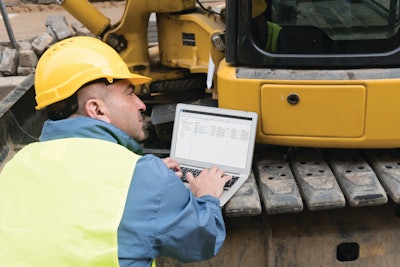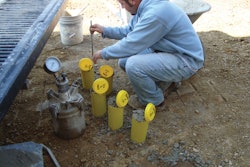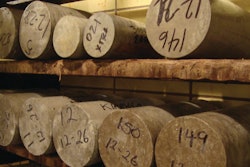
For firms engaged in heavy construction work, maintaining a healthy equipment fleet is both vital for project success and the successful management of capital expenses. Taking proper care of those heavy iron machines and vehicle fleets that keep projects moving is one of the most critical responsibilities today’s modern contractors have. For a contractor with a capital and operating budget of $10 million or more for heavy equipment, even a 1% savings on equipment costs could add hundreds of thousands of dollars directly to the bottom line.
Properly maintaining equipment, however, means tracking and understanding the data that these machines produce. And capturing accurate equipment information is a challenge that many contractors face. Data collection and analysis has traditionally been a manual process, and many times information would slip through the cracks leading to equipment being poorly maintained, overused or even retired before necessary.
To maximize equipment investments, one must first understand the differences and relationship between ownership and operating costs, leverage the right tools and technologies to obtain accurate field data on performance and usage, and make data-driven decisions to optimize fleet management and maintenance.
Owning vs Operating
When a piece of equipment is purchased, there are ownership costs that occur regardless of how the machine is used. These costs are typically fixed annually and are based on the purchase price, interest, depreciation, licensing, insurance and taxes. As a machine ages, the incremental cost of ownership declines, due mostly to a slowdown in the rate of depreciation.
Operating costs, however, go up over time depending on how the equipment is used and maintained. As the machinery ages, increases in fuel and oil consumption, routine maintenance and parts replacement, and unexpected repairs occur.
As ownership and operating costs move in these different directions over the lifecycle of equipment there is typically a point of optimal return on investment. This “sweet spot” occurs when the increasing cost of operations begins to dominate the benefits of a decreasing cost of ownership for a machine. This is when the machine is the most profitable but also when the incremental total costs of having that machine in your fleet begin to rise.
Knowing where equipment stands in the fleet lifecycles can make a significant difference in knowing how each piece of machinery should be used on jobs, when to devote more resources to maintenance, and ultimately when to look at replacing equipment to keep fleets productive in the field.
Why Aim for the ‘Sweet Spot?’
Beyond merely controlling equipment costs and managing maintenance plans, contractors rely on the optimum performance of equipment for nearly every facet of construction on the project. Having a truly optimized fleet of machinery is vital to keeping projects fluidly moving. By leveraging the mass volume of data that equipment produces and effectively analyzing it to find the true equipment management sweet spot, contractors are also able to:
- Achieve more accurate job costing by understanding exactly how equipment usage (or non-usage) costs factor into the project’s overall budget and performance. This leads to more accurate estimates, which leads to more profitable projects and more work won.
- Maximize equipment usage (and productivity) by evenly spreading equipment usage across projects and/or scaling equipment use to best serve current and future needs. A typical contractor wouldn’t pay the salaries of three employees to sit in the office each day and do absolutely nothing, but many contractors have equipment that is not being used properly, is sitting idle for long lengths of time, or is being misused on jobsites — all of which lessen the value on investment.
- Maximize both the work life and value of equipment. By having data-informed strategic equipment use plans in place, contractors can push that sweet spot even further out, extending equipment shelf life to gain additional value from their long-term capital investments.
- Make smarter equipment asset decisions. When it does come time to make new equipment investments, having solid historical data and a keen knowledge of where equipment sweet spots lie for typical projects helps contractors decide whether to own or lease equipment, what types of equipment should be financed or purchased outright, when makes the best sense to sell or turn in leased equipment and more.
The Tools to Make Smarter Equipment Decisions
So, how can contractors achieve optimal equipment management? For data collection, technologies like telematics, mobile applications for equipment data collection in the field, and equipment capture technologies like Bluetooth and RFID are becoming more prevalent and powerful. The real hurdle for most companies is figuring out what to do with the data once captured.
Few construction or financial managers have the time to parse and crunch the data on field operational costs on their whole fleet, combine that with data on incremental owning costs, and uncover the real rates at which their machines should be charged as costs against their jobs — a rate that changes over time for each machine. Fewer still have the time to track the trends in those rates to see when it starts to make sense to retire certain machines and invest in new ones. Yet, this is exactly what needs to happen if they are going to realize that bump to the bottom line.
The good news is that there are software applications — many integrated into existing construction ERP platforms — that can automate and streamline these processes, allowing equipment managers to take large sets of data, parse and analyze them, and create detailed reports. These applications help equipment managers know the real rates that should be applied to the use of the machines in their fleet and have information on hand to help with the difficult decisions of when to sell, buy or rent. When integrated into an ERP, this data can directly update job cost estimates and projections, ensuring that accurate bids are created and that accurate job profitability is recorded.
If repair, maintenance, ownership costs and meter readings are diligently recorded for each piece of equipment, a company can accurately predict equipment lifecycles and optimal returns on investments. Creating historical data on the cost curves for owning and operating heavy equipment allows much more informed decisions about when to invest more in their fleet or when certain machines should be sold. Contractors can avoid the common problem of waiting too long to replace a piece of equipment. Using more informed data and metrics to create equipment benchmarks, they know when a machine will become more expensive to keep than it is worth.
Jeremy Larsen is vice president of product management for Viewpoint, a global provider of integrated software solutions for the construction industry.




















